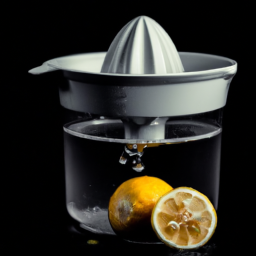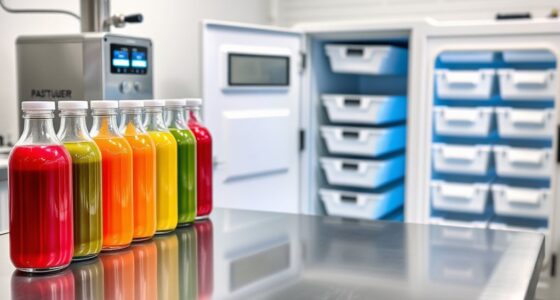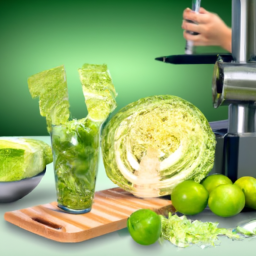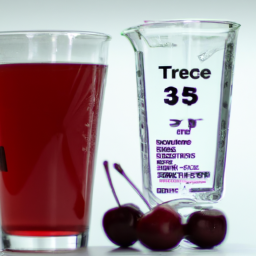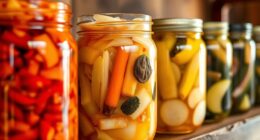I don’t know about you, but for me, there is nothing quite like the zesty, tangy flavor of freshly squeezed lemon juice. Whether it’s used to add a kick of sourness to a savory dish or to bring out the sweetness in a refreshing summer drink, lemon juice is a versatile ingredient. It can brighten up any dish with its vibrant, lemony zest.
But have you ever found yourself wondering just how much juice you can get from one lemon? Well, wonder no more! In this article, we’ll explore the factors that affect lemon juice yield, share tips for maximizing your lemon juice output, and even provide a handy conversion chart for fresh lemon juice to bottled.
So, grab your juicer and let’s get squeezing!
Key Takeaways
- The yield of lemon juice can be affected by factors like temperature and ripeness, with ripe and fresh lemons yielding more juice.
- One lemon can yield an average of 2-3 tablespoons of juice, which is helpful to know for recipes that call for specific amounts of juice.
- Using a lemon squeezer is more efficient and easier to use than a hand juicer for extracting juice.
- Storing leftover lemon juice in airtight containers or ice cube trays can prevent waste.
Factors Affecting Lemon Juice Yield
Did you know that factors like temperature and ripeness can greatly impact how much juice you can get from a single lemon? When it comes to lemon juice acidity, it’s important to note that the acidity level of a lemon can affect how much juice it produces. A lemon with a higher acidity level will typically yield more juice compared to a lemon with a lower acidity level.
Another factor to consider is lemon freshness and ripeness. A fresh and ripe lemon is much easier to juice compared to an old and unripe one. A lemon that has been sitting around for a while may have lost some of its moisture, which can lead to a lower juice yield. Additionally, an unripe lemon will likely have a thicker skin, making it more difficult to extract juice from.
Now that we’ve covered the factors that impact lemon juice yield, let’s move on to discussing the average yield of lemon juice.
Average Yield of Lemon Juice
Surely you must be aware of the typical amount of tangy liquid that can be extracted from a solitary citrus fruit. On average, one lemon can yield about 2-3 tablespoons of juice. However, the amount of juice you can extract from a lemon can vary depending on a few factors.
The ripeness of the lemon can affect the amount of juice it produces. A ripe lemon will contain more juice than an unripe one.
The temperature of the lemon can also impact juice yield. A room temperature lemon will produce more juice than a cold one taken straight from the fridge.
Lemon juice extraction techniques can make a difference in the amount of juice extracted. Squeezing the lemon with your hands may not be as effective as using a juicer or reamer.
Lemon juice is not only a popular ingredient in cooking, but it also has a variety of health benefits. It’s a good source of vitamin C, which can boost the immune system and improve skin health. Lemon juice also contains antioxidants and has anti-inflammatory properties.
As we’ve seen, the amount of juice that can be extracted from a single lemon varies. In the next section, we’ll explore some tools that can help with extracting the most juice possible from your lemons.
Tools for Extracting Lemon Juice
Extracting the most from a single citrus fruit can be made easier with the aid of specialized tools. Two popular options for extracting lemon juice are the lemon squeezer and the hand juicer. The lemon squeezer is a handheld tool that allows you to extract juice by squeezing the lemon between two handles. It is quick and efficient, and can easily extract a large amount of juice from the lemon. On the other hand, the hand juicer is a manual tool that requires more effort to use, but can also be effective in extracting juice from the lemon.
To contrast the two tools, here is a table that summarizes their differences:
| Tool | Ease of Use | Efficiency | Cost |
|---|---|---|---|
| Lemon Squeezer | Easy | High | Low |
| Hand Juicer | More Effort | Moderate | Low |
Using either tool can help you get the most juice out of your lemon. However, it’s important to note that the type of tool you use may depend on personal preference and the amount of juice you need.
Now, let’s move on to some tips for maximizing lemon juice yield.
Tips for Maximizing Lemon Juice Yield
To get the most out of your citrus fruit, it’s helpful to know some tricks for increasing the amount of liquid you can extract. One way to maximize lemon juice yield is to roll the fruit on a hard surface before juicing it. This helps to break down the lemon’s fibers, making it easier to extract the juice. Another tip is to microwave the lemon for a few seconds before squeezing it. This warms up the fruit and helps to release more juice.
In addition to these tips, there are also ways to preserve lemon freshness and make alternative uses for leftover lemon peels. To keep your lemons fresh for longer, store them in a plastic bag in the refrigerator. You can also freeze lemon juice in ice cube trays for later use. As for leftover peels, they can be used to make lemon zest or infused in water for a refreshing drink.
With these tips in mind, you’ll be able to extract as much juice as possible from your lemons and make the most of their flavor and nutritional benefits.
When it comes to measuring lemon juice, there are a few different methods you can use. One option is to simply squeeze the lemon directly into a measuring cup, making sure to strain out any seeds or pulp. Another option is to use a citrus juicer, which can help to extract more juice and make the process easier. Regardless of which method you choose, knowing how much juice you can get from one lemon is helpful for recipes that call for specific amounts of juice.
How to Measure Lemon Juice
You can easily gauge the tartness of your recipe by pouring a few drops of the acidic liquid from a freshly squeezed lemon into your mouth. However, when it comes to measuring the actual amount of lemon juice needed for a recipe, the best way is to use a measuring cup or spoon.
Typically, one medium-sized lemon produces around 2-3 tablespoons of juice, but this can vary depending on the size and ripeness of the fruit. To get the most juice out of your lemon, roll it on a hard surface before cutting it in half and using a juicer or your hands to squeeze out the juice.
For recipes that call for lemon zest, you can also use a microplane or fine grater to remove the outer layer of the lemon peel. This adds a burst of citrus flavor without the tartness of the juice.
If you don’t have fresh lemons on hand, alternatives to fresh lemon juice include bottled lemon juice or even vinegar in a pinch. However, the flavor may not be as bright and fresh as using freshly squeezed lemon juice.
When converting lemon juice from fresh to bottled, keep in mind that the concentrated nature of bottled juice means you will need less for the same amount of tartness. For example, if a recipe calls for 2 tablespoons of fresh lemon juice, you may only need 1 tablespoon of bottled juice. It’s important to taste as you go to ensure the right balance of flavors in your dish.
Converting Lemon Juice from Fresh to Bottled
When using bottled lemon juice as a substitute for the fresh variety, it’s important to keep in mind that the concentrated nature of the bottled juice means that less is needed to achieve the same level of tartness.
While fresh lemon juice contains a higher amount of vitamin C and other beneficial nutrients, bottled juice can be a convenient alternative for those who don’t have access to fresh lemons or are short on time.
It’s worth noting that bottled lemon juice often contains preservatives and additives that fresh lemon juice does not. Some brands may also contain added sugar or artificial flavors. Therefore, it’s important to read the label carefully and choose a brand that best fits your needs and dietary preferences.
With the knowledge of the differences between bottled lemon juice vs. fresh and the nutritional value of lemon juice, you can make an informed decision on which type of juice to use in your recipes. This will be helpful when we move onto the subsequent section about the conversion chart for lemon juice.
Conversion Chart for Lemon Juice
Funny how a little chart can turn a sour situation into a sweet one – the conversion chart for lemon juice is a handy tool for any kitchen.
This chart provides a quick reference guide for how much juice to expect from different sizes of lemons. Whether you need a small amount for salad dressing or a larger quantity for a recipe, this chart takes the guesswork out of measuring.
Lemon juice is a versatile ingredient that can be used in a variety of ways. It can add brightness and acidity to dishes, enhance the flavor of fruits and vegetables, and even offer health benefits when consumed on its own.
Drinking lemon juice can help with digestion, boost the immune system, and provide a natural source of vitamin C. With all these uses and benefits, it’s no wonder that the conversion chart for lemon juice is such a valuable resource in the kitchen.
Speaking of which, let’s move on to some delicious recipes using lemon juice.
Recipes Using Lemon Juice
I love using lemon juice in my cooking and today, I want to discuss three of my favorite recipes that use lemon juice.
First up, lemonade – it’s a classic summertime drink that’s perfect for quenching your thirst on a hot day.
Next, salad dressing – lemon juice adds a bright and tangy flavor to any salad and can help balance out richer ingredients like cheese or avocado.
Finally, marinade – lemon juice can help tenderize meat and adds a zesty flavor to chicken or fish.
Lemonade
To make lemonade, you’ll need to squeeze about 1/4 cup of juice from a fresh lemon. Here are four reasons why you should consider making lemonade at home:
-
It’s healthier than store-bought lemonade that’s often loaded with sugar and preservatives.
-
You can customize the sweetness and tartness to your liking by adjusting the amount of sugar and lemon juice.
-
Lemonade is a refreshing drink that’s perfect for hot summer days.
-
You can experiment with flavored variations like raspberry lemonade or lavender lemonade for a unique twist.
Moving on to the next topic, let’s talk about salad dressing.
Salad Dressing
You might be thinking that making your own salad dressing is too difficult, but it’s actually really simple and much healthier than store-bought options. One of the main benefits of making your own dressing is that you can customize the flavor to your liking.
There are endless flavor combinations you can try, from classic vinaigrettes to creamy dressings. You can also experiment with alternative ingredients, like using citrus juice instead of vinegar or adding honey for sweetness.
When it comes to making your own salad dressing, it’s important to remember that a little goes a long way. Start with a small amount and add more as needed. You can always adjust the seasoning to your liking.
Another great thing about making your own dressing is that you can control the ingredients. You can use healthier oils and avoid preservatives and artificial flavors. With all the options available, making your own salad dressing is a great way to elevate your salads and make them more enjoyable.
Now, let’s move on to the next section about marinades.
Marinade
Marinating your meat in a flavorful mixture of herbs, spices, and acid, such as vinegar or wine, can add depth and complexity to your dishes. One of my go-to acids for marinades is lemon juice. Not only does it add a bright, tangy flavor, but it also helps to tenderize the meat. But did you know that lemon juice has alternative uses in marinades beyond just adding flavor?
Here are some flavor combinations to try with lemon juice in your marinade:
| Ingredient | Complimentary Flavors |
|---|---|
| Garlic | Olive oil, rosemary, thyme |
| Soy sauce | Ginger, honey, sesame oil |
| Dijon mustard | Honey, tarragon, shallots |
Using lemon juice in your marinade is a versatile way to infuse your meats with flavor. But what do you do with any leftover juice? In the next section, I’ll share some tips on how to store your leftover lemon juice.
Storing Leftover Lemon Juice
Don’t let leftover lemon juice go to waste; simply store it in the fridge for later use! Here are three ways to do it:
-
In airtight containers: Pour the leftover juice into a small, airtight container, making sure to leave some headspace for expansion. Label the container with the date and store it in the fridge for up to five days.
-
In ice cube trays: Pour the juice into an ice cube tray and freeze it. Once frozen, transfer the cubes to a resealable plastic bag and store them in the freezer for up to six months. This freezing technique is perfect for those times when you need just a small amount of lemon juice for a recipe.
-
Alternative uses: If you don’t plan on using the leftover lemon juice for cooking, try using it for other purposes. For example, you can mix it with water and use it as a natural cleaning solution, or add it to your bathwater for a refreshing soak.
By following these simple storage tips, you can make sure that every drop of lemon juice goes to good use. So, the next time you have some leftover lemon juice, don’t toss it out – save it for later!
Frequently Asked Questions
How long does it take to extract juice from a lemon?
I’ve found that the amount of time it takes to extract juice from a lemon can vary depending on the squeezing technique used. Some people prefer to roll the lemon on a hard surface before cutting and squeezing, which can help release more juice. Generally, it takes me about 1-2 minutes to extract the desired amount of juice from a lemon.
Can I use a blender to extract lemon juice?
I’ve found that using a blender for lemon juice extraction is possible, but not the most efficient. It’s better to use a juicer or hand squeeze for larger quantities. Blender extraction can be useful for small batches, like for lemonade recipes.
How many lemons do I need to make a cup of lemon juice?
Did you know that one lemon yields approximately 1/4 cup of juice? To make a cup of lemon juice, you’ll need about 4 lemons. If fresh lemons aren’t available, try using substitutes like vinegar or lime juice. Regular consumption of lemon juice can boost your immune system, aid digestion, and improve skin health.
How long can I store leftover lemon juice and what is the best way to store it?
I can store leftover lemon juice for up to a week in the refrigerator, using an airtight container or a plastic wrap directly on the surface. Adding sugar or salt can act as natural preservatives.
Can I use bottled lemon juice instead of fresh lemon juice in recipes?
I prefer using fresh lemon juice in recipes because of its benefits. When choosing lemons for juicing, look for ones that are heavy and have thin skin. Bottled lemon juice may be convenient, but it lacks the same flavor and nutrients as fresh juice.
Conclusion
In conclusion, getting the most out of your lemons is all about understanding the factors that affect juice yield, using the right tools, and following a few simple tips. With an average yield of around 2-3 tablespoons of lemon juice per fruit, it’s important to make the most of every squeeze.
Whether you’re using a hand-held juicer, a reamer, or simply squeezing by hand, be sure to apply even pressure and rotate the fruit for optimal results. To measure your lemon juice accurately, use a liquid measuring cup or a kitchen scale.
And remember, if you don’t need all the juice at once, it’s easy to convert fresh juice to bottled juice for later use. Just follow the conversion chart and store your leftover juice in the fridge for up to a week.
Whether you’re adding a little zing to a salad dressing, brightening up a marinade, or whipping up a batch of lemon bars, knowing how much juice to expect from your lemons is key to success. So go forth, squeeze with confidence, and enjoy the tart and tangy flavor of this versatile citrus fruit.
Ilana has been a vegan for over 10 years. She originally made the switch for health reasons, but soon found herself becoming more and more passionate about the ethical and environmental implications of a vegan lifestyle. Ilana is the author of The Graceful Kitchen, a blog all about veganism. She loves to cook up delicious and nutritious vegan meals, and share her recipes with others who are interested in leading a cruelty-free life. Ilana is also a strong advocate for using whole foods as the foundation of a healthy diet, and believes that going vegan is one of the best ways to achieve this.

